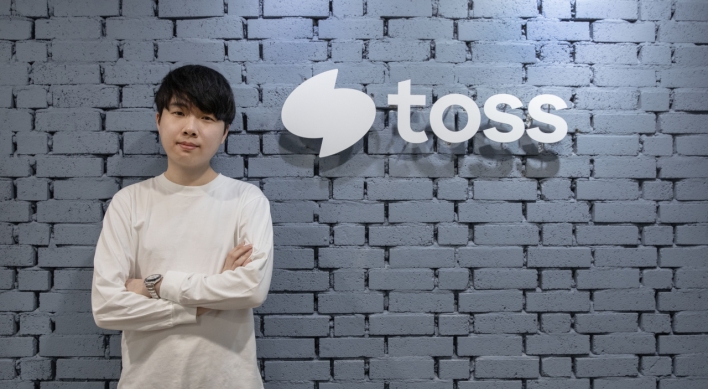[Weekender] In search of the roots of Korean Catholicism
South Chungcheong is holy ground for Korean Catholicism and symbol of Christian martyrdom
By Lee Woo-youngPublished : Aug. 8, 2014 - 21:45
DANGJIN, South Chungcheong Province ― Excitement over the pope’s visit prevails in South Chungcheong Province, with welcome placards hung at entrances of rural towns. Nestled in South Korea’s central region along the west coast, the province is usually not the most-visited tourist destination for Korean or foreign tourists.
“We’ve never had a VIP guest like Pope Francis visit the region and I don’t think we ever will in the future,” said Kim Jeong-gyum, director of the culture and tourism division of Seosan City Government, which is overseeing the pope’s visit to Haemi Martyr Site next week.
The leader of 1.2 billion Catholics is scheduled to spend three days of his five-day stay in the province.
The bay area of the region was where Catholicism first arrived in the country and grew rapidly in the late 1700s. The area spans the four towns of Dangjin, Yesan, Hongseong and Seosan. The once-flourishing sea trade area was open to new ideas and culture and was one of the first regions to accept Christianity during the Joseon period. It spread quickly among commoners and slaves who were discontent with the strict social class system and inequality of the Confucian Joseon era.
Shrine of Solmoe
The Shrine of Solmoe, the birthplace of St. Andrew Kim Tae-gon, Korea’s first Catholic priest, is one of the highlights of the pope’s visit. The pope is expected to meet young Catholics who will attend Asia Youth Day, on Aug. 15.
As “solmoe” means pine tree hill, the place is surrounded by a lush pine tree forest. Aside from being a major Catholic place, the pine trees here create a serene landscape, making it one of the nine greatest sceneries announced by the city of Dangjin.
“We’ve never had a VIP guest like Pope Francis visit the region and I don’t think we ever will in the future,” said Kim Jeong-gyum, director of the culture and tourism division of Seosan City Government, which is overseeing the pope’s visit to Haemi Martyr Site next week.
The leader of 1.2 billion Catholics is scheduled to spend three days of his five-day stay in the province.
The bay area of the region was where Catholicism first arrived in the country and grew rapidly in the late 1700s. The area spans the four towns of Dangjin, Yesan, Hongseong and Seosan. The once-flourishing sea trade area was open to new ideas and culture and was one of the first regions to accept Christianity during the Joseon period. It spread quickly among commoners and slaves who were discontent with the strict social class system and inequality of the Confucian Joseon era.
Shrine of Solmoe
The Shrine of Solmoe, the birthplace of St. Andrew Kim Tae-gon, Korea’s first Catholic priest, is one of the highlights of the pope’s visit. The pope is expected to meet young Catholics who will attend Asia Youth Day, on Aug. 15.
As “solmoe” means pine tree hill, the place is surrounded by a lush pine tree forest. Aside from being a major Catholic place, the pine trees here create a serene landscape, making it one of the nine greatest sceneries announced by the city of Dangjin.
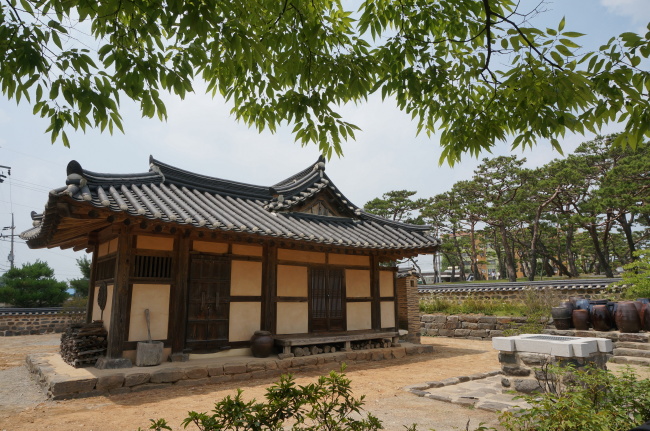
In the middle of the shrine’s grounds stands a 15-meter wooden statue of Jesus on the cross. This is where visitors on a pilgrimage pause for a moment and pray before they look around other facilities.
The shrine consists of the old “hanok,” or traditional house, where the late priest’s family used to live, an outdoor theater guarded by the 12 apostles’ statues and a museum with a church that houses some of Kim’s remains. The museum displays letters and documents that tell of the journeys and hardships Kim had gone through to become the first Catholic priest in Korea.
Priest Kim is said to have left Solmoe when he was 7. As a noble, Kim and his family led a decent, wealthy life here until his grandfather was prisoned after admitting to being Catholic. His grandfather died in a major persecution of Catholics in 1814.
Kim’s family has a total of 11 martyrs among four generations, including his grandfather, great uncle and father.
Christianity was not accepted during the late Joseon period. Catholics were regarded as mutineers against Confucian values and social order. First-generation martyr Yoon Ji-chung was persecuted because he didn’t hold an ancestral ritual and therefore, was branded a rebel dangerous to social hierarchy.
Priest Kim died as a martyr in 1846, less than a year after he was officiated as the first Korean Catholic priest. His remains are now housed at 209 churches and museums across the country.
A visitor whose baptismal name is Monica said her church keeps one of Kim’s fingers.
“I go to the St. Andrews Kim Tae-gon Church in Seongnam and we have his little finger at the church. I’m on a pilgrimage in South Chungcheong Province. The Solmoe Shrine is a must-visit place for any Catholic,” she said after attending morning mass at the church inside the Solmoe Shrine.
Kim Tae-gon’s birthplace is the start of the 11-km Beogeunae pilgrimage path that goes through other historical Catholic sites such as Hapdeok Catholic Church, the graveyard of St. Son Ja-seon and other unknown martyrs, and Shin-ri Holy Land.
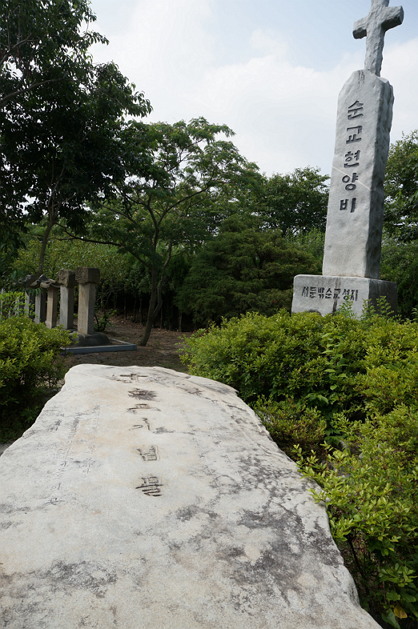
Haemi Martyr Site
Pope Francis will wrap up his time in the province on Aug. 17 in Haemi, once a killing field during the Catholic oppression about 140 years ago.
Unlike the meaning of the name “beautiful sea,” Haemi was where the largest number of Catholics were persecuted. Those whose names are known account for 132 who died in the Byeongin Persecution from 1866 to 1871. Names of martyrs who were commoners or slaves are not known and the number of those persecuted may actually be double or triple.
According to a description in the local travel guide, the site was “a pool of blood” from martyrs. Hundreds of Catholics died in the most horrifying ways. One of the most gruesome executions was throwing people on a large stone to death. The stone, now called “Martyr’s Stone” is located in the garden of the Haemi Martyr Site, a memorial for martyrs.
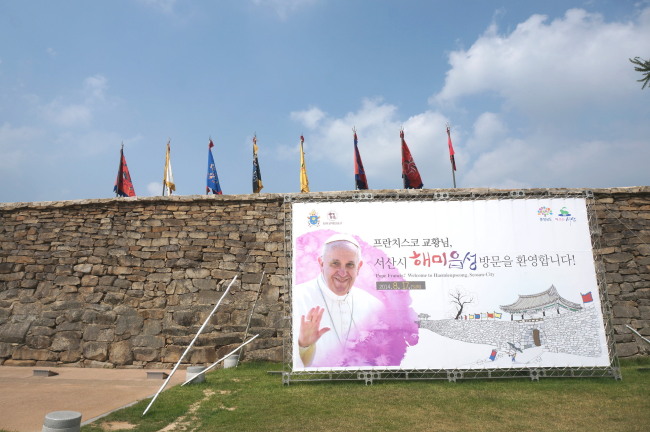
The large gray flat rock now serves as a prayer site for Catholic visitors. As a sign reads “please kneel down and pray,” visitors pay their respects to scores of unnamed martyrs.
As there were too many to execute, persecutors buried them alive outside the Haemi-eup Wall, then the largest army post in the country that commanded the entire Chungcheong Province army. The pope will hold a mass on the large area of the old army command site on Aug. 17.
Haemi-eup Wall had two large prisons in the town where Catholics were put to stay before execution. The more than 300-year-old tall locust tree just outside the prison was a torture tool as well. Prisoners had their hair tightly tied to the tree by a steel wire and were hung there until they confessed. The faint marks left by the steel wire offer a glimpse into the cruelty.
Hapdeok and Gongseri Catholic churches
The two identical churches, though not included in the pope’s itinerary, are meaningful places in Catholicism, and hidden travel gems for non-Catholics.
Designed and built by a French priest in the 1920s, Hapdeok and Gongseri Catholic churches are twin churches with the same Gothic-style of red brick walls, pointed arches and colored windows. They offer a picture-perfect scene with centuries-old trees and scenic trails that lead from the churches.
They also have witnessed almost a century of Korean Catholicism.
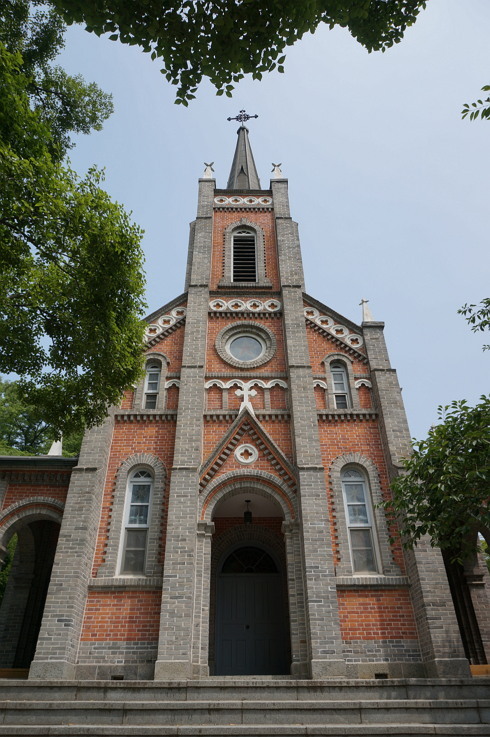
Hapdeok Church in Dangjin has served as a spiritual fortress for oppressed Korean Catholics. Since its founding, it has never stopped conducting Masses. It also served as a medical and education center for local residents. According to the guide, it attracted a growing number of residents by giving farm land or renting it at low rates. It took care of children while their parents went out to work in the fields.
Gongseri Church is known as the most beautiful Catholic church by the Korea Tourism Organization. The red-brick Gothic church is small, yet picturesque with centuries-old trees and a pilgrimage pathway that surrounds it. The small museum on the church site offers understanding of the history of Korean Catholicism and martyrdom and some interesting activities by the church in the 1800s, such as distributing an ointment developed by a priest named Devise as a cure to every disease back then.
By Lee Woo-young (wylee@heradcorp.com)



![[AtoZ into Korean mind] Humor in Korea: Navigating the line between what's funny and not](http://res.heraldm.com/phpwas/restmb_idxmake.php?idx=644&simg=/content/image/2024/04/22/20240422050642_0.jpg&u=)


![[Herald Interview] Why Toss invited hackers to penetrate its system](http://res.heraldm.com/phpwas/restmb_idxmake.php?idx=644&simg=/content/image/2024/04/22/20240422050569_0.jpg&u=20240422150649)

![[Graphic News] 77% of young Koreans still financially dependent](http://res.heraldm.com/phpwas/restmb_idxmake.php?idx=644&simg=/content/image/2024/04/22/20240422050762_0.gif&u=)






![[Exclusive] Korean military to ban iPhones over security issues](http://res.heraldm.com/phpwas/restmb_idxmake.php?idx=652&simg=/content/image/2024/04/23/20240423050599_0.jpg&u=)

